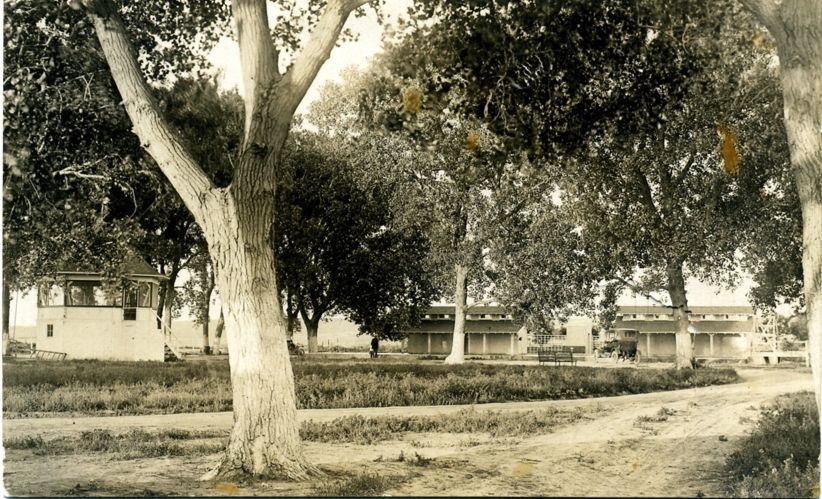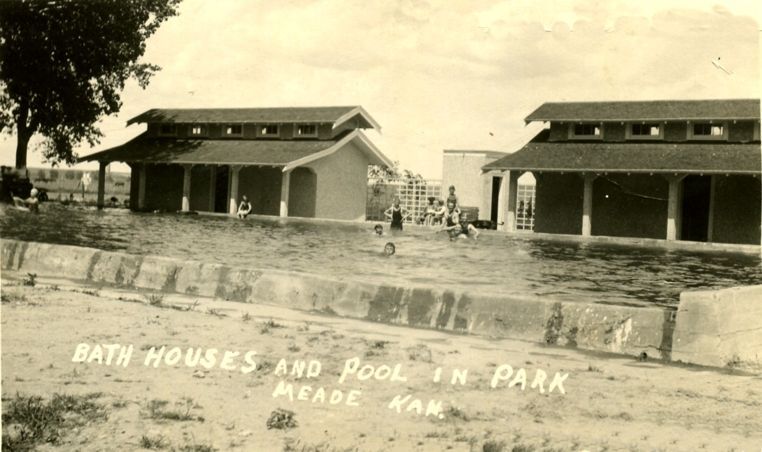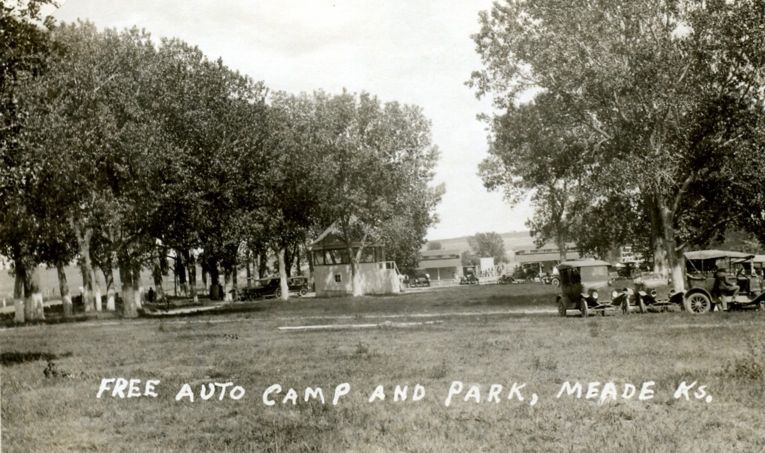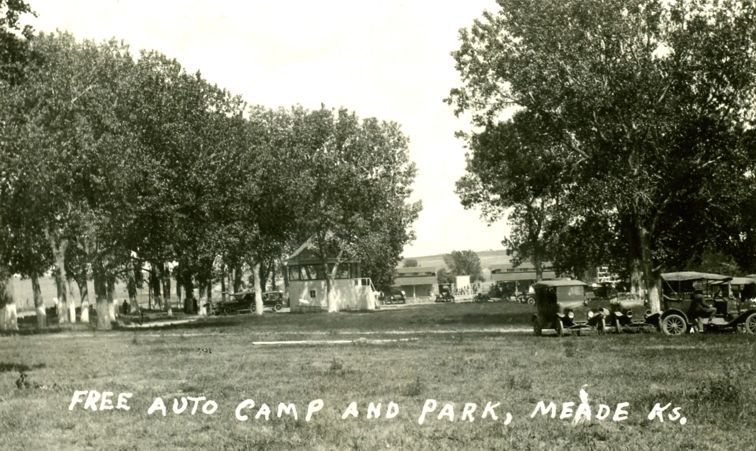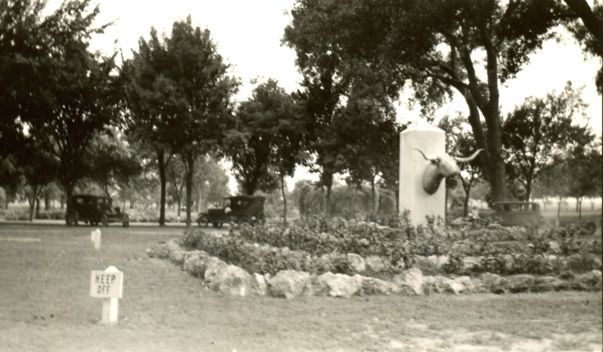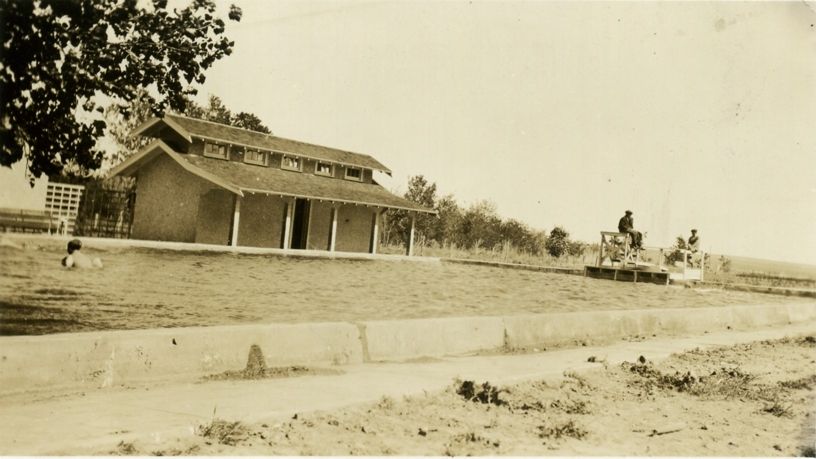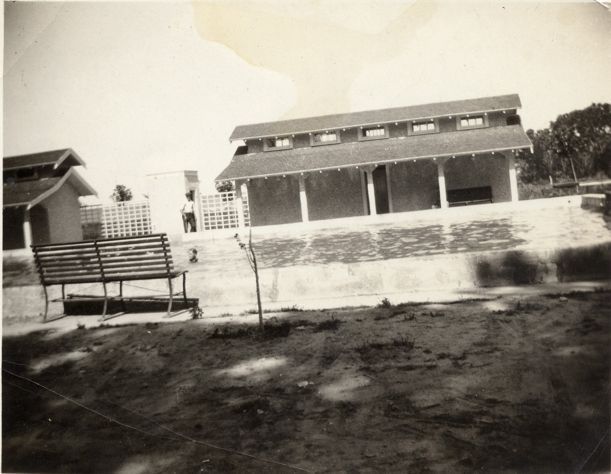By Nancy Ohnick
Reprint with permission from Hometown History, Hometown Summer 1993.
Copyright 1993 Ohnick Enterprise
Research for this article was done by Irene Lemaster whose grandfather, Ernest Fletcher, was very instrumental in the creation of the Meade City Park and built Meade’s first swimming pool. We are certain Irene spent many hours in that first pool as a kid and isn’t it ironic that her husband, Leroy, should be mayor of Meade now as the latest renovations are done to the present facility? Thanks, Irene, for your excellent research and the loan of priceless photos depicting the fun side of our “Hometown History!”
In the Meade Globe-News, July 1, 1920 issue, Frank Fhur, the editor, ran a story about the Meade Commercial Club and its current project, a camping ground for autos located a half mile east of Meade. The proposed park was located in a shady grove on the Fred Stalder farm. Four acres were leased by the city and the project was underway.
At this time Highway 54 was routed much differently than it is today. The road made a 90 degree turn north on what is now North State Street (the intersection at Taylor’s and the Circle O Motel) and was then very much at the edge of town running north to the county road then curving eastward and eventually joining the current route at the north end of the big “s” curve east of town. The highway was re-routed in the early 1950’s to its present form.
Highway 160 wasn’t created until the early 1930’s, so the new city park would have been several blocks “off the beaten path” at the time.
The Meade State Lake was not developed until 1925, and there wouldn’t have been a “proper” place to camp for quite some distance. In those days of unpaved highways an auto trip would not have been the high speed comfort it is today. Undoubtedly, a shady grove of cottonwood trees with cool artesian well water would have looked pretty good to a weary traveler!
Businessmen to the core, the ambitious members of the Commercial Club were aware of what tourism meant to a town, and when this group started a project it usually got done in a big way. The park was named the Artesian Valley Camp Ground and by July 22, 1920, the Globe-News was reporting great progress:
An Artesian Well is Added.
The auto camping ground east of town is destined to become one of the most frequented and popular places anywhere near Meade. One of the most pressing needs of the campground was water. Now it is there in abundance and in the shape of one of the nicest artesian wells in the valley. The flow is three gallons per minute. The water is clear and cold and was struck at a depth of 125 feet. The flow was reduced to half-inch pipe and forms one of the most perfect drinking fountains and is certainly a most valuable acquisition to the grounds. The constant rustle of the big cottonwoods that produce a welcome shade along with the other attractions being added is giving Meade a much longed-for-park. The place is certainly attractive and is not only an excellent advertisement for our city and county but an every-day source of pleasure. The tract consists of five acres, most of which is covered with large trees. Everyone who visits the place is charmed by its natural attractions and it is being given wide publicity and ere long will be one of the well-know turn-in places in the southwest.
By December of that first year members of the Meade Commercial Club and several businessmen of Meade went together and purchased the four acres of ground from J.J. Stalder, and more improvements were in the planning stages. In February, 1921, the paper reported that the park had been fenced and citizens were being encouraged to donate trees to be planted to “further beautify” the grounds. The Meade Globe-News reported: “There are already a number of cottonwood trees on the site, but as they are rather a short life tree, and since it takes several years to grow trees large enough for shade, it might be well to consider the item of tree planting and have some started to take the place of the present ones, a little later on.”
The Commercial Club ordered the trees and by March 24, thirty white ash trees had arrived. Each citizen who elected to pay for a tree was expected to help plant it and take care of it.
In the April 21, 1921, issue the Meade Globe-News reported that the bandstand had been moved to the city park. As near as we can tell, it originated on the corner of Carthage and Meade Center about where the little Centennial Park is downtown.
Willis Wolfe hitched two Fordsons to the trucks and soon whisked the structure to the prettiest little park in all this part of the state. Another artesian well is being put down to supply the swimming pool which is being constructed and a commodious bunk house and kitchen will add to the conveniences. For an attractive place to while the happy hours away, this Meade Auto Park and Camping Grounds is hard to beat.
Soon two more artesian wells were completed and all attention was turned to the construction of Meade’s first swimming pool. The paper carried the following story on May 12, 1921.
Log Rolling at City Park.
Ernie Fletcher, the daddy of the city park, for it was Ernest who first started the ball, is enthusiastic over the way things have been going for the past six weeks. Since then the band stand has been moved to the park, two additional fine artesian wells have been brought in with a splendid water supply, a large number of shade trees have been planted, some grading of driveways has been done and considerable other work on the grounds. Now comes the crowning job, and that is the 50 x 100 foot swimming pool. It is estimated that it will take 400 sacks of cement and 100 loads of sand to build this reservoir. It will be built gradually sloping and when filled the depth of the water will be from two feet to six feet. The depression on the east side will be sued and the excavation will be easy. Mr. Fletcher is planning to have an old-time log-rolling with a free for all dinner and build the big swimming pool in one day; he says it can be done after the forms are all laid. We believe our people are a unit in the park improvement program and that they will rally to the aid of Mr. Fletcher. “It was estimated to take $1,500 to construct the pool.
The people of Meade responded. Donations started pouring in immediately and the name of contributors were listed each week in the Meade Globe-News. Jake Cornelson, who lived twenty miles south-east of town was the first farmer to offer sand hauling services. Jake brought a four-horse team and hauled sand for two days. Soon wheat harvest temporarily interrupted the sand hauling and other work donated by area farmers, but by June 30 the forms for the walls were up and the concrete was being poured for the new swimming pool.
In the meantime another addition to the park was the construction of a shelter to house a register for tourists to sign. The Globe reported: “Mr. A.O. Rosenberry comes in for the credit of the idea, and the making and placing of the box, while to Mr. H. Lelewyn Jones goes credit for the register which is sufficiently large to take care of several years. Since the completion of the road due west of Meade and the opening of the auto park, there has been a noticeable increase in the number of tourists passing this way…” In order to inform the growing number of tourists about Meade County, information was soon added to the register, articles about the artesian wells, the old salt well, the Country Club and Big Springs Ranch, the silica industry and more. Pictures were also placed there to help educate the traveler about our region. The names of 1,932 tourists were recorded in the register between the first of July, 1921, and the first of January, 1922.
Fourteen well-constructed park benches were donated to the park that summer. Members of the Arena Club presented six and the following named business firms, one each: F.W. Fick, W.F. Casteen & Co., Braden Grocery Co., A.M. McCay, E.C .Lepper, Meade State Bank, First National Bank and Meade Globe-News.
All these projects paled, however, in comparison to the construction of the swimming pool. In the Meade Globe-News July 14, edition; “It is estimated that the pool will hold 200,000 gallons and that the artesian wells will fill this reservoir in about three days. This big stream of water will be continually running into the pool and will keep the water constantly fresh and pure. To temper the water a large stream will run in a trough around the wall of the pool. We are safe in saying that Meade will have a swimming pool that is unequaled anywhere in the state. And it is free for everybody.” On July 21, it was reported that the water had been turned into the swimming pool. Master Emery Ellis claimed the honor of having the first plunge.”
By the end of the summer electric lights had been added to the park and in the spring of 1922, two bath houses were added to the swimming pool. The park started to experience growing pains as the season progressed, one Sunday in June it was estimated that from 300 to 500 cars had crowded into the camp ground and parking had become a real problem on Sundays when people came from all over the area to enjoy Meade’s park and pool. A special election was held on June 27, and the result was that the City of Meade took over the operation of the park.
The artesian well as a means of filling the swimming pool was abandoned in 1923, in favor of more efficient pumped water as sanitation regulations dictated the pool be emptied on a regular basis. All through the summer of 1923, the park and pool grew in popularity. The Globe reported in the August 15 edition, “A record crowd visited the Meade Park and swimming pool just last Sunday. By actual count 320 cars were parked at one time, and it is estimated that fully 2,000 people were on the grounds. The swimming pool was filled all hours of the day, and the shade of the big trees was an ideal place to spend the day. The big attraction was the Minneola Band, which paid the park a visit that day. Their music was exceptionally fine, and the concerts were well received by the large crowd present. The Minneola Band is one of the finest musical organizations in this part of the state, and their services have been secured for the big Meade County Fair, August 20-30 inclusive. About fifty cars from Minneola accompanied their band. Bucklin, Ashland, Fowler, Englewood, Forgan, Liberal, Plains, Montezuma, many other near-by towns as well as points in Colorado were represented in Meade that day.”
It wasn’t long before the city park and swimming pool were no longer “news” to the editor or the Meade Globe and we kind of lost track of its progress through the late 1920’s. In 1933, Dr. O.H. Simpson of Dodge City donated a cement statue of a steer head to the Meade City Park. The stone walls and shelter house would have been erected in the late 1930’s as W.P.A. (Works Progress Administration) or C.W.A. (Civil Works Administration) projects, but we could not obtain exact details of their construction. (UPDATE: 20012, We have learned that the rock used in the construction of the shelter house and rock walls at the park were obtained from the railroad. A large railroad water well was deconstructed and the rock, which was shipped to Meade originally from points east, was used to build them. This explains why that rock is so much darker in color than the other rock used in W.P.A. projects in town such as the Dalton Gang Hideout and the old MHS grandstands.)
The swimming pool served the community well until 1956, at which time it was closed by the Kansas State Board of Health. Ernie Fletcher and the men who built the old pool provided thirty-five years of fun and summer refreshment to the community of Meade.
Meade voters went to the polls on December 11, 1956, and voted to build a new modern pool. The city purchased ground just to the west of the city park, and in February, 1957, construction started, this time to the tune of $70,000. That winter gave us one of the worst blizzards in recent history, but the pool was finished in time for the 1957 swimming season.
Last fall the city approved a bond issue to help pay for a major renovation project to our now, thirty-six-year-old pool. Work progressed through the winter while Mother Nature once again dumped record snow fall upon us. The pool was given a major overhaul, transforming it into three sections including a baby pool, and an intermediate pool. The bath houses were completely replaced and a new sun shade constructed on the west side. If history repeats itself, we should be set for about another thirty-five years!
By the way, that first pool, constructed back in 1922, has recently been resurrected as a basketball court by the city and the Meade Recreation Commission. Ernie, your legend lives on in your old hometown!
Note on cement statue of steer: In June, 1933, a concrete foundation was built in the city park on which was mounted a steer head created and presented to the city by Dr. O.H. Simpson of Dodge City. The statue was an exact replica of the range steer so plentiful in this area during the days of the big cattle drives. The work was done in cement and provided quite a conversation piece to the park for many years. We are not sure when it disappeared, but the concrete base still stands just south of the north shelter house in the park. Although long gone, that statue will always be a fond memory of the kids of the 1930’s through the 1960’s who climbed on it and hung from it’s horns.
